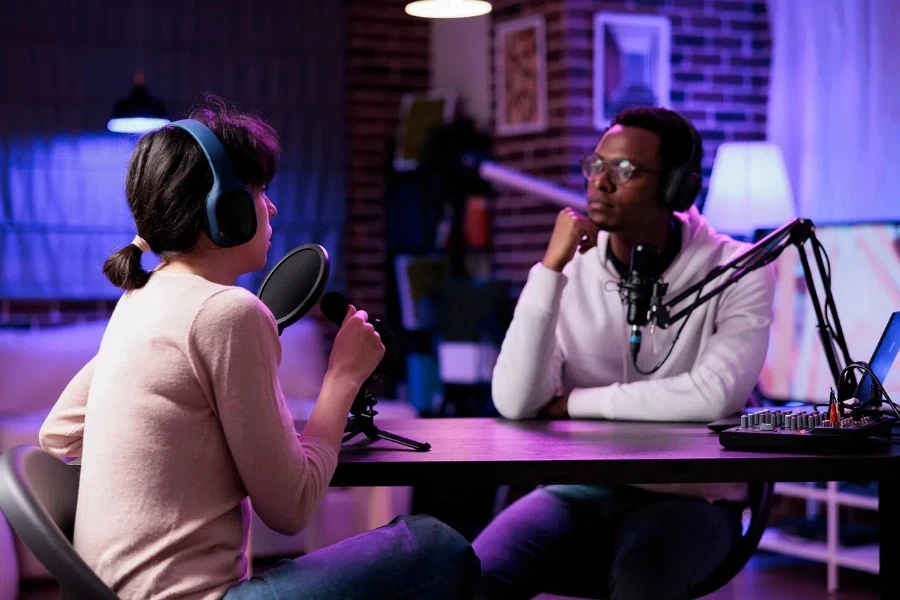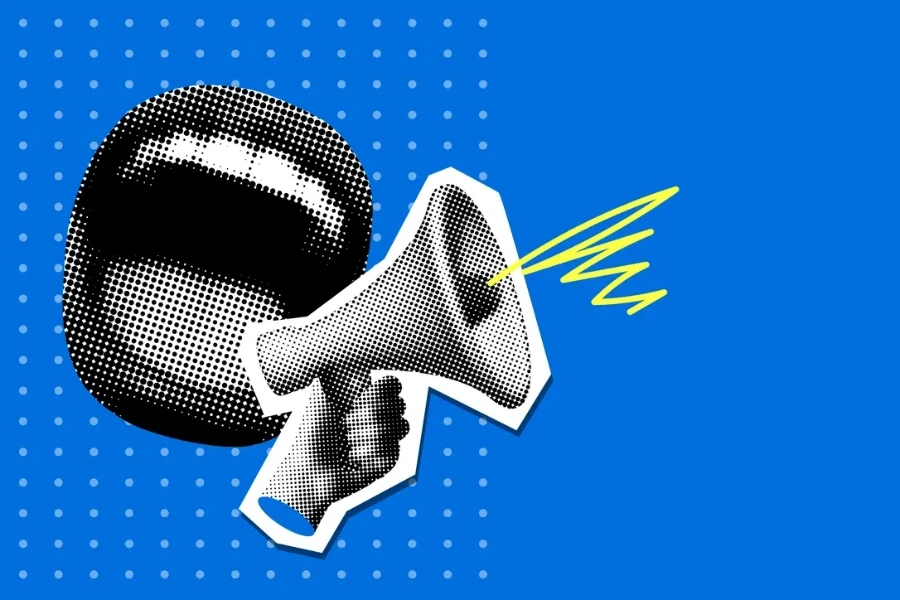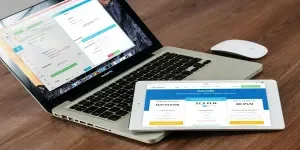The rising popularity of podcasts reflects a drastic shift in how we consume content. It’s interesting how those living room conversations are now happening over a larger scale and entertaining a broader audience. With more than 3 million worldwide podcasts and billions of listeners, it’s evident that podcasting is set to revolutionize content consumption for the years to come.
Even more fascinating is that there’s no need for hefty investments to initiate a podcast. There’s a low-barrier to entry as it only requires a microphone, an internet connection, and a creative idea.
Our easy-to-follow guide covers all the variables involved in starting a podcast. Feel free to bookmark this article and use it to refer back whenever you want to read more about the process!
Table of Contents
What is a podcast?
Essentials to set up a podcast for free
Steps to start a free podcast
Parting notes
What is a podcast?

A podcast is a series of episodes covering a particular theme or topic. When you enter the podcast world, you’ll find multiple categories of these audio or video discussions. It can be:
- A single person speaking into a microphone sitting in an apartment or a studio.
- A pair or a group of friends.
- A serious chat with a subject-matter expert.
- A funny, boisterous, quirky, or sarcastic talk with celebrities, influencers, or politicians.
At its core, a podcast needs a topic and a solid voice to give it life. This helps speakers and social activists expand their reach and connect more profoundly with their target audience.
Essentials to set up a podcast for free

A podcast can cost as little as you want and even free. Various free resources, tools, and platforms help aspiring podcasters establish themselves in the digital landscape. A few prerequisites to start a podcast are:
- Concept: Finalize a topic and plan how you will set your show apart. Identify potential listeners and the podcast format (recording space, episode length, guests). Choose a unique name and cover art that will become your identity on social media platforms.
- Production: High-quality audio without any background noise is essential for any podcast. Choose a reliable microphone and editing software to refine the episodes.
- Host and distribute: The next step is to choose the right hosting platform. Explore free hosting services that offer tools to upload and run the episodes. Then, select distributions like Apple Podcasts, Spotify, or Google Podcasts.
- Promotion: To grow, you need attention from potential listeners. Leverage free promotional platforms like social media and email newsletters. Replying to comments and engaging in discussion forums can help build a vibrant community.
According to research, 80% of podcasts fail. But with the grit and a step-by-step guide, you’ll have no trouble gaining traction for your podcast. Remember, consistency is the key. Don’t give up if the first podcast episode doesn’t turn out as expected. Keep standing and refining your craft using alternative methods and the latest tools.
Steps to start a free podcast
Once you have a clear picture of how the podcast should look, it’s time to get to work. This step-by-step guide on starting and setting up a podcast can help all aspiring podcasters!
- Choose a niche

The niche you choose sets up the tone for your show. It determines potential listeners, the kind of cover art that fits, and the social media platforms where it’ll be a big hit. Think about the type of podcast you want to make and clearly define your goals.
Knowing your purpose is key, whether you aim to be seen as an expert, share interesting stories, or keep your audience informed about news and trends. This helps you set realistic expectations—while some podcasts quickly gain fame, most grow a loyal audience over time.
- Plan the format

Having a clear vision for a new podcast makes things smooth from the start. There are several podcast formats, so you should evaluate all of them to choose the right one. It should be something you love. If you are good at speaking, go solo. If you perform better in a group, invite some guests. Or it could be a combination of the two.
Popular podcast formats include interviews, co-hosted conversations, scripted non-fiction stories, news summaries, educational episodes, and fictional storytelling. Remember, a script for your podcast, especially for solo episodes or in-depth topics, helps you stay focused and clearly communicate your message. If working with co-hosts, keeping the group small makes scheduling easier, as coordinating more than two or three people can be challenging.
Unnecessary padding or fluff in the discussions wears off the readers. A podcast should be interesting, on-point, and as concise as possible. Buzzsprout Platform Statistics show that most podcast episodes typically last between 20 to 40 minutes, while the next most common length ranges from 40 to 60 minutes.
- Arrange the recording setup

Some of the big names in the industry started podcasts from their homes. For instance, The Joe Rogan Experience began as a casual home setup in 2009 and grew into one of the biggest podcasts, later signing a USD 100 million deal with Spotify.
The best part is that you can use household items to create a recording space and basic podcast equipment to finish the job. Blankets, pillows, or foam panels can help reduce background noise and make your recording space more comfortable. Also, pay attention to lighting and seating to improve your setup and create a better experience for you and your guests.
Don’t worry if you’re starting and don’t have an external microphone. You can use your phone or computer’s built-in mic to begin recording. Once the setup grows, investing in the latest podcast equipment after market research is a good idea. For example, look into different types of microphones, like dynamic, condenser, and USB mics, to choose the best one for your needs. Consider your budget, recording space, and how you plan to use it.
Adjust your microphone placement and use tools like pop filters or windshields to reduce unwanted noise and improve audio quality. Learning basic audio editing skills, like noise reduction and equalization, can also help make your podcast sound more professional.
- Work on the podcast branding

Branding a podcast is vital to creating a solid image. The podcast name, cover art, official background music, and theme should all stand apart from the competition. Factors that make a podcast unique are:
- Its name: There’s no perfect name strategy for a podcast. It could be named after a podcast host or have a quirky blend of words that grab attention. Aim for short, unique names with creative inclusion of keywords. SmartLess, a humorous interview podcast hosted by Jason Bateman, Will Arnett, and Sean Hayes, can be a good example. Some free tools that could help select a good podcast name are Namify and Squadhelp.
- Its intro and outro: Your podcast intro and outro are essential parts of your show. A strong intro helps grab listeners’ attention and encourages them to stay until the end—and hopefully return for more episodes. A good outro wraps things up in a way that keeps your audience interested and connected. Audacity and Anchor are free podcast editing tools that could help create a powerful intro and outro.
- Its trailer: You might not be aiming for an Academy Award, but that shouldn’t stop you from creating a podcast trailer. This short preview gives potential listeners a quick glimpse of your show, showcasing what makes it unique and why they should listen. Try to tell people about the notable themes of this podcast, add the music, a compelling hook, and a strong CTA (call-to-action) to make an impact. Check out free versions of Canva, Audacity, and Speaker Studio to emphasize the audio and video assets of a podcast.
You don’t have to stick to just one trailer. If your podcast follows a seasonal format, you can make a new trailer for each season to highlight new themes, upcoming guests, and exciting segments.
- Write a powerful description

Write an engaging podcast description that clearly explains what the podcast offers. A good description can encourage people to listen.
Include an attention-grabbing hook, a quick summary of the topics you’ll cover, and any unique features that will appeal to your audience. Adding relevant keywords to your description can also help people find your podcast more easily in search results.
The description should briefly introduce the podcast host and explain why people should tune in. Make sure to update it regularly to include new episodes, guest appearances, or special features so that it stays fresh and keeps listeners engaged.
- Promote the podcast

Use free promotional methods to boost your podcast’s visibility. Social media platforms like Twitter (X), Facebook, Instagram, and LinkedIn are great for sharing updates about new episodes, engaging with your audience, and joining conversations in your podcast’s niche.
Create eye-catching graphics, teaser clips, or behind-the-scenes content to grab your followers’ attention and motivate them to listen. If you’re doing a video podcast, share a snippet of an upcoming episode to spark interest and encourage listeners to download and tune in. Even the most popular personalities like Michele Obama are using the same strategies. For her podcast, The Michelle Obama Podcast, Michelle used social media to promote her podcast, including sharing clips of interviews and inspirational quotes. She used platforms like Instagram and Twitter to connect with her audience directly.
Another great way to promote your podcast is by teaming up with other podcasters or creators in your niche. You can collaborate through guest appearances, cross-promotions, or joint marketing efforts. Working with creators who share similar interests can be a win-win for both, helping to expand your reach and grow your audience.
Parting notes

Don’t expect a lot of money to flood in a few months after starting a podcast. When you drop the first podcast episode and promote it right, you’ll likely not get much response from potential listeners. Still, keep working hard to refine the craft. Sometimes, starting and improving along the way is better than waiting for that perfect podcast idea. There are many examples of people in the podcast world who nearly gave up just before they were about to break through.
Stay tuned to Alibaba Reads to learn more about the latest digital market trends and to explore equipment to create stellar podcasts!



